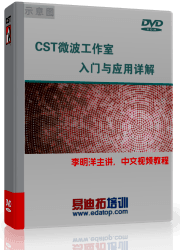- 易迪拓培训,专注于微波、射频、天线设计工程师的培养
Time Domain Analysis Using TimeFEKO
Time Domain Analysis Using TimeFEKO

http://www.feko.info/feko-product-info/technical/special-module-and-feature-articles/timefeko
Brief description on how TimeFEKO can be used to get time-domain information from FEKO.
FEKO is based on a frequency domain formulation. Time-domain information can however be obtained by applying Fourier Transforms on broadband frequency-domain data. The specification of time-domain pulse shapes and the required frequency domain simulations is automated by the TimeFEKO module.
Available Pulse Forms
- Gaussian
- Ramp
- Double exponential
- Triangle.
The time domain response of the mono-static scattered electric field (Ez) is to be determined for a Gaussian pulse illuminating a cube along the x-axis.
Surface currents at 250 MHz.

Time domain response of the incident and the scattered field.

学习学习!
feko能够设置高斯普?
那的确很爽,能不能设置锥面柱的激励呢?
不是很清楚....锥面柱的激励
但是這是在時域下才可以做.
*.tim input file 跟 Defining the pulse form
25 The program TIMEFEKO
25.1 Description
With the program TIMEFEKO electromagnetic scattering problems can be solved in the
time domain. It is based on the program FEKO (that does the relevant calculations in the
frequency domain) and an FFT algorithm (that transforms the data to the time domain).
For the excitation a number of different pulses have been pre-defined and stored in the
function library (see section 25.3.1).
The program TIMEFEKO is constructed in such a way that all the data in the output
file (*.out) from FEKO is transformed, i.e. in the input file the cards have to be specified
in the correct way to ensure that the correct data is transformed. Information on the
correct card definitions is given in the following section.
The program TIMEFEKO uses two input files,10 that have to be created by the user.
25.3 The *.tim input file
In the file *.tim the pulse form, position and the point in time are assigned. This file
consists of a number of sections which are optional at present.
• Set the pulse form with characteristic value and the time shift.
• Set the value of the highest frequency and the sampling points.
• Set the normalisation (normalise time to the speed of light).
• Set whether the output is written to the output file.
• Set the time points.
In the *.tim file, empty or comment lines (starting with **) are allowed. The parameters
need not be entered in any particular column, but they have to be in the correct order.
The keywords used in the *.tim file exist in German and English (for example ANREGUNG
and EXCITATION). Both versions of each keyword will be given in the discussion below.
25.3.1 Defining the pulse form
The assignment of the pulse form is necessary. Each pulse has a predefined
particular characteristic parameters. The parameters must be assigned absolute
and not normalised values. The amplitude factor u0 is 1. It can be changed
Ax card (in the file *.pre) with the appropriate amplitude value.
Time shifting t0: indicates the time (in seconds) that the pulses are delayed
in Figure 25-1). The time shift should be such that the excitation of the
t = 0 is approximately 0. Since both the time and frequency domain data
this is not strictly required, but it simplifies working with the results.
1. Gaussian pulse GAUSS / GAUSS (see Figure 25-2)
Example:
** Pulse form
GAUSS
** t0 Exponent a
2.0E-08 3.0E+08
2. Triangular pulse DREIECK / TRIANGLE (see Figure 25-3)
Example:
** Pulse form
TRIANGLE
** t0 Impuls Duration T
2.0E-08 1.0E-08
3. Double exponential pulse DEXP / DEXP (see Figure 25-4)
Example:
** Pulse form
DEXP
** t0 T tau1 tau2
0.0 10.0E-09 5.0E-9 10.0E-9
4. Ramp pulse RAMPE / RAMP (see Figure 25-5)
Example:
** Pulse form
RAMP
** t0 Impuls Duration T tau1 tau2
20.0E-09 15.0E-09 5.0E-09 10.0E-09
5. Double exponential impulse (second type) DBLEXP / DBLEXP (see Figure 25-6)
Example:
** Impulse form
DBLEXP
** Time. t0 Parameter tau1 Parameter tau2
20.0E-9 70.0E-9 5.0E-9
开始还认为是时域积分方程求解,原来傅氏变换来的
如果能把fdtd的功能加入进来
估计用的人会更多
感謝 cem-uestc 的關注...
目前是 傅氏变换来.... 沒錯.... 頻域的東西就是如此.... 但是至少讓使用者可以轉到時域下去觀看他想看的問題.
目前還沒 FDTD Code 加入.這是明確的....以後也許會有...
這是明確的....以後也許會有...
webhugo 语法有问题 哈哈
抱歉..也就是說 .... 目前僅有 MOM, FEM, UTD, PO, GO, MLFMM, GA ...
但是沒有 FDTD Code.....
目前想要看 Time Domain 僅能透過 Fourier Transforms ... (跟 網路分析儀一樣...都是需透過轉換)
FEKO is based on a frequency domain formulation. Time-domain information can however be obtained by applying Fourier Transforms on broadband frequency-domain data.
恩 就是
赶紧加入FDTD把XFDTD的人 叫来
有没有人算过这个example啊?
怎么后处理?
postfeko打不开timefeko计算后的文件。
利用 EXCEL 等小工具...將 Cube.aus 工具做出來..
难道真的要别的工具做,后处理不能做啊
timefeko,how to deal with it?
不知道怎么使用TIMEFEKO, 学习中……












 沪公网安备 31011202014168号
沪公网安备 31011202014168号
 1427313829
1427313829 旺旺在线
旺旺在线 Skype Online
Skype Online 13761612886
13761612886 官方淘宝店
官方淘宝店
